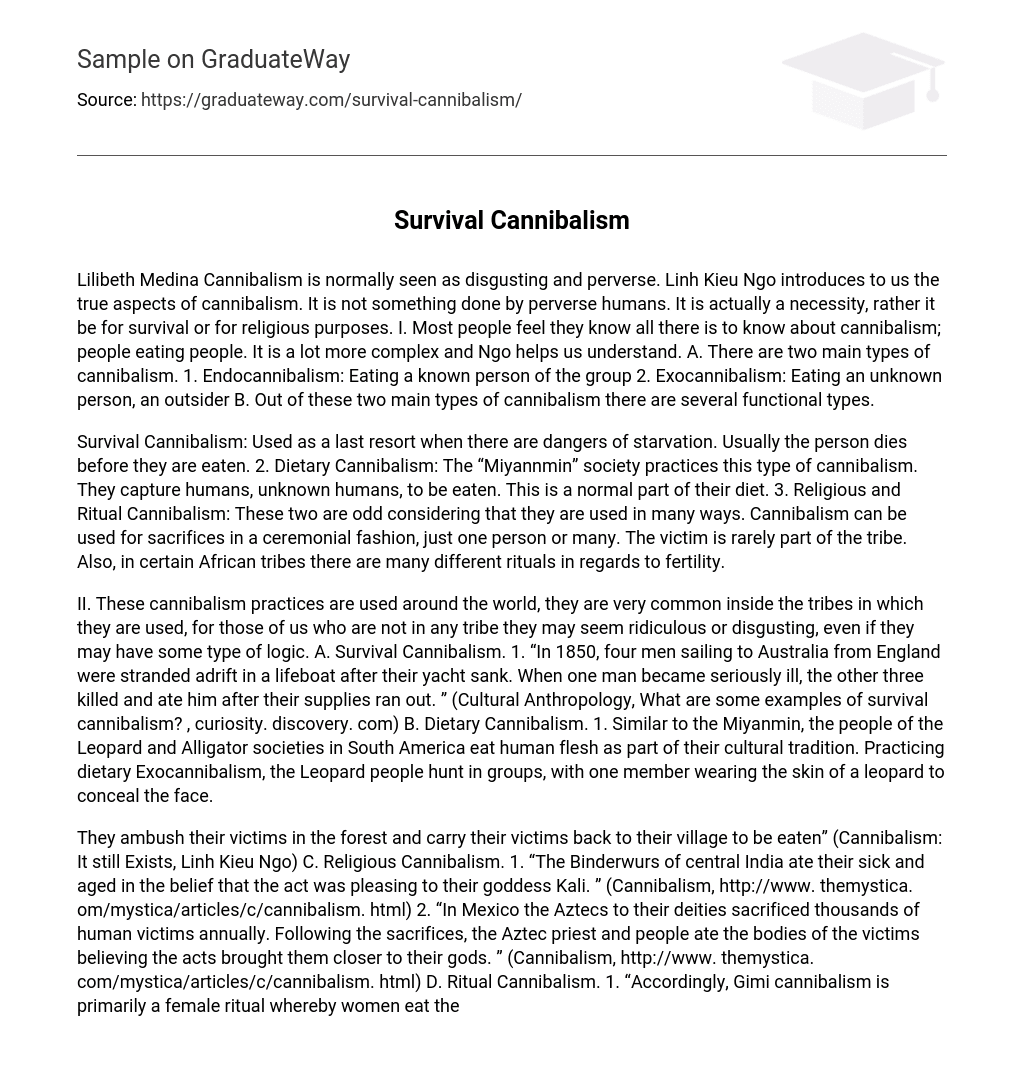In her argument, Lilibeth Medina emphasizes that cannibalism is widely seen as disgusting and abnormal. However, Linh Kieu Ngo challenges this perspective by offering a more accurate understanding of cannibalism. According to Ngo, cannibalistic acts are not limited to morally corrupt individuals but can also be driven by survival or religious reasons. Moreover, Ngo argues that most people have a superficial understanding of cannibalism as simply consuming human flesh, when in reality it is a much more intricate phenomenon.
Cannibalism can be divided into two primary categories: endocannibalism, which involves consuming someone from within one’s own group, and exocannibalism, which entails eating an outsider who is unfamiliar to the group. Within these overarching classifications, there exist various subtypes with specific purposes.
Cannibalism can be categorized into three types. Firstly, survival cannibalism is used as a desperate measure to avoid starvation. In most cases, the person who is eaten has already died. Secondly, dietary cannibalism is practiced by the “Miyannmin” society, where humans are captured and consumed as a regular part of their diet. Lastly, religious and ritual cannibalism serve various purposes. It can be used as a sacrificial ceremony involving one or multiple individuals, with the victims typically not belonging to the tribe. Additionally, certain African tribes have diverse fertility-related rituals.
II. Cannibalistic practices are prevalent worldwide and are particularly common among tribes. While these practices may appear ridiculous or repulsive to those outside the tribes, they often have a certain rationale.
A. Survival Cannibalism.
1. An example of survival cannibalism occurred in 1850 when four men sailing from England to Australia were left stranded in a lifeboat after their yacht sank. When one of the men fell seriously ill and their supplies ran out, the other three had no choice but to kill and eat him (Cultural Anthropology, What are some examples of survival cannibalism?, curiosity.discovery.com).
B. Dietary Cannibalism.
1. Similar to the Miyanmin tribe, the Leopard and Alligator societies in South America incorporate human flesh into their cultural traditions. These societies practice dietary exocannibalism, and during group hunts, one member disguises their face by wearing a leopard skin (Cultural Anthropology, What are some examples of survival cannibalism?, curiosity.discovery.com).
According to Linh Kieu Ngo, there are various forms of cannibalism that remain prevalent. One form is cultural or survival cannibalism where individuals consume human flesh in order to survive extreme circumstances. This has been observed among tribes like the Korowai of New Guinea who surprise their prey in the forest and bring them back to their village for consumption.
Another type is religious cannibalism, which involves consuming human flesh as part of religious ceremonies. For example, the Binderwurs of central India believed that eating their sick and elderly pleased their goddess Kali. Similarly, the Aztecs in Mexico would sacrifice numerous human victims to their deities and then consume their bodies as a means of getting closer to the gods.
Lastly, there exists ritual cannibalism primarily practiced by women from the Gimi tribe. These women consume the bodies of their own children, husbands, and parents as a countermeasure against the life-draining powers associated with the mother deity.
Sources:
Cannibalism: It still Exists, Linh Kieu Ngo
Cannibalism
Ritual Cannibalism: Past and Present, James R.
James R. Coffey from spirituality.knoji.com states that the Wari tribesman in Brazil have a unique mourning ritual. After a tribesman dies, their family members mourn and cry over the body for several days until it decomposes. Once this occurs, the body is divided into smaller portions, starting with the brain, heart, and liver. These parts are then cooked and placed on ceremonial mats before being shared among relatives. The most valuable pieces are given to parents and elders because consuming them allows the Wari to absorb their loved ones’ essence. This act of consumption is seen as a way to strengthen their own inner selves.





